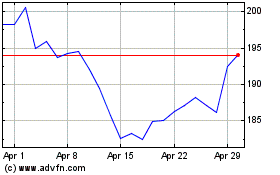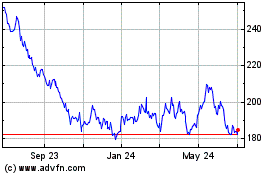By Annie Gasparro
This article is being republished as part of our daily
reproduction of WSJ.com articles that also appeared in the U.S.
print edition of The Wall Street Journal (February 14, 2020).
Kraft Heinz Co. and other big food makers are ramping up
advertising after years of cost cutting, recognizing a need to
rekindle enthusiasm for their condiments, candies and snacks.
Kraft Heinz, which reported lower fourth-quarter sales on
Thursday, said additional spending was necessary to bolster its
strongest products as shoppers have drifted toward lower-price
store brands and newer niche products.
"You need to nurture brands, take care of them, to keep them
meaningful after 150 years," Chief Executive Miguel Patricio said
in an interview.
Shares in Kraft Heinz fell 7.6% to $27.77 after the maker of
Oscar Mayer meats and Jell-O desserts reported $6.54 billion in
quarterly sales, short of analyst expectations and down 5.1% from a
year earlier.
Other food makers are also boosting marketing after years
focused on cost cuts that accelerated profits but crimped sales
growth. Hershey Co., Kellogg Co., Unilever SA and Oreo-maker
Mondelez International Inc. are all spending more on advertisements
and in-store promotions.
"That's how we connect with consumers and keep our brands
relevant," Hershey CEO Michele Buck said in an interview.
Hershey's advertising expenses in North America rose 5% in the
fourth quarter, and the chocolatier ran a commercial for its new
Reese's Take 5 bar during this year's Super Bowl.
Kellogg also bought ads during the Super Bowl for Pringles and
Pop-Tarts, snack brands the company is counting on to help make up
for tepid cereal sales.
"That's the big leagues," Steve Cahillane, Kellogg's chief
executive, said of paying a lofty price for the impact of a Super
Bowl commercial. He said it is worth taking a temporary hit to
profit if it fosters long-term sales potential. TV broadcaster Fox
Corp. charged as much as $5.6 million for 30 seconds of advertising
time during this year's National Football League championship
game.
Mondelez increased ad spending for the first time in five years
in 2019, to $1.21 billion from $1.17 billion the year before, and
it plans to spend more again this year.
Some companies say they are paying for new marketing with cuts
elsewhere. Unilever, maker of Hellmann's mayonnaise and Breyers ice
cream, increased marketing spending by roughly $75 million last
year. Chief Executive Alan Jope said the funds came from savings
generated through zero-based budgeting, a method of aggressive
cost-management popularized by 3G Capital, a Brazilian firm
invested in Kraft Heinz and other consumer-goods companies.
At Kraft Heinz, 3G stripped out nearly $2 billion in annual
spending after the 2015 merger of Kraft Foods and H.J. Heinz. But
the company has fallen short of its sales goals. Last year it also
reduced the value of some of its best-known brands by a combined
$17 billion.
Mr. Patricio, who took over after the biggest of the
write-downs, is now investing again, leading to lower margins for
key brands including Oscar Mayer deli meat and Philadelphia cream
cheese.
Kraft Heinz on Thursday lowered the value of its Maxwell House
brand by $213 million. The coffee has fared poorly amid the rise in
high-end, trendy coffee and new flavors. Kraft Heinz also lost
market share in cheese and cold cuts in the quarter, while
condiment sales remained strong.
Mr. Patricio, who took over last June, said Kraft Heinz would
continue to spend more on marketing for big brands that drive
profitability. He didn't name those brands. Analysts expect Heinz
condiments, Philadelphia cream cheese and Planters nuts to be among
the brands drawing increased investments.
Last year, Kraft Heinz embarked on its first global ad campaign
to mark Heinz's 150th anniversary. The company collaborated with
singer Ed Sheeran -- who has a tattoo of the Heinz logo on his arm
-- to sell a limited-edition ketchup dubbed "Edchup."
This year, Kraft Heinz is increasing spending on television ads
and other consumer-oriented marketing by 30% while cutting
less-visible expenses like agency fees. Mr. Patricio said he aims
to make the company's supply chain more efficient and reduce the
complexity of its sprawling operations to fund new investments.
"We could put the savings on the bottom line, but that's not
what we want to do. We want to invest in our brands," he said.
For the fourth quarter, Kraft Heinz posted a 2.2% drop in
comparable sales globally, including a 2.7% decline in the U.S.,
its biggest market. The sales metric excludes the effect of
currency fluctuations, mergers and divestitures.
The company's profit for the period was $182 million, or 15
cents a share, compared with a loss of $12.57 billion a year
earlier. Excluding certain items affecting comparability, its
adjusted profit of 72 cents a share beat analyst estimates by four
cents.
Micah Maidenberg
contributed to this article.
Write to Annie Gasparro at annie.gasparro@wsj.com
(END) Dow Jones Newswires
February 14, 2020 02:47 ET (07:47 GMT)
Copyright (c) 2020 Dow Jones & Company, Inc.
Hershey (NYSE:HSY)
Historical Stock Chart
From Mar 2024 to Apr 2024

Hershey (NYSE:HSY)
Historical Stock Chart
From Apr 2023 to Apr 2024
